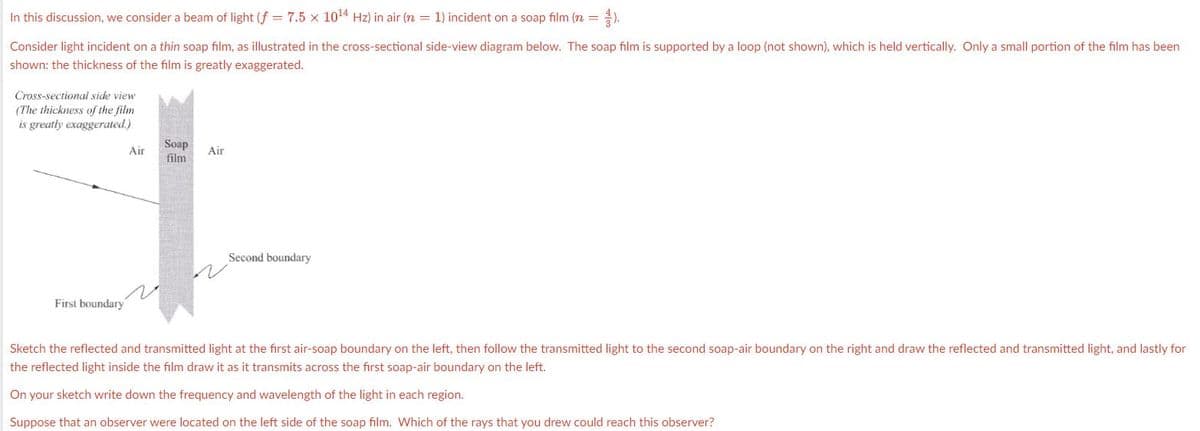In this discussion, we consider a beam of light (f = 7.5 x 10¹4 Hz) in air (n = 1) incident on a soap film (n =). Consider light incident on a thin soap film, as illustrated in the cross-sectional side-view diagram below. The soap film is supported by a loop (not shown), which is held vertically. Only a small portion of the film has been shown: the thickness of the film is greatly exaggerated. Cross-sectional side view (The thickness of the film is greatly exaggerated.) First boundary Air Soap film Air Second boundary Sketch the reflected and transmitted light at the first air-soap boundary on the left, then follow the transmitted light to the second soap-air boundary on the right and draw the reflected and transmitted light, and lastly for the reflected light inside the film draw it as it transmits across the first soap-air boundary on the left. On your sketch write down the frequency and wavelength of the light in each region. Suppose that an observer were located on the left side of the soap film. Which of the rays that you drew could reach this observer?
In this discussion, we consider a beam of light (f = 7.5 x 10¹4 Hz) in air (n = 1) incident on a soap film (n =). Consider light incident on a thin soap film, as illustrated in the cross-sectional side-view diagram below. The soap film is supported by a loop (not shown), which is held vertically. Only a small portion of the film has been shown: the thickness of the film is greatly exaggerated. Cross-sectional side view (The thickness of the film is greatly exaggerated.) First boundary Air Soap film Air Second boundary Sketch the reflected and transmitted light at the first air-soap boundary on the left, then follow the transmitted light to the second soap-air boundary on the right and draw the reflected and transmitted light, and lastly for the reflected light inside the film draw it as it transmits across the first soap-air boundary on the left. On your sketch write down the frequency and wavelength of the light in each region. Suppose that an observer were located on the left side of the soap film. Which of the rays that you drew could reach this observer?
Principles of Physics: A Calculus-Based Text
5th Edition
ISBN:9781133104261
Author:Raymond A. Serway, John W. Jewett
Publisher:Raymond A. Serway, John W. Jewett
Chapter27: Wave Optics
Section: Chapter Questions
Problem 63P: Both sides of a uniform film that has index of refraction n and thickness d are in contact with air....
Related questions
Question
Please explain and sketch prediction problem as instructed on the problem

Transcribed Image Text:In this discussion, we consider a beam of light (f = 7.5 × 10¹4 Hz) in air (n = 1) incident on a soap film (n =).
Consider light incident on a thin soap film, as illustrated in the cross-sectional side-view diagram below. The soap film is supported by a loop (not shown), which is held vertically. Only a small portion of the film has been
shown: the thickness of the film is greatly exaggerated.
Cross-sectional side view
(The thickness of the film
is greatly exaggerated.)
First boundary
Air
Soap
film
Air
Second boundary
Sketch the reflected and transmitted light at the first air-soap boundary on the left, then follow the transmitted light to the second soap-air boundary on the right and draw the reflected and transmitted light, and lastly for
the reflected light inside the film draw it as it transmits across the first soap-air boundary on the left.
On your sketch write down the frequency and wavelength of the light in each region.
Suppose that an observer were located on the left side of the soap film. Which of the rays that you drew could reach this observer?
Expert Solution
This question has been solved!
Explore an expertly crafted, step-by-step solution for a thorough understanding of key concepts.
This is a popular solution!
Trending now
This is a popular solution!
Step by step
Solved in 2 steps with 2 images

Knowledge Booster
Learn more about
Need a deep-dive on the concept behind this application? Look no further. Learn more about this topic, physics and related others by exploring similar questions and additional content below.Recommended textbooks for you

Principles of Physics: A Calculus-Based Text
Physics
ISBN:
9781133104261
Author:
Raymond A. Serway, John W. Jewett
Publisher:
Cengage Learning

University Physics Volume 3
Physics
ISBN:
9781938168185
Author:
William Moebs, Jeff Sanny
Publisher:
OpenStax

Principles of Physics: A Calculus-Based Text
Physics
ISBN:
9781133104261
Author:
Raymond A. Serway, John W. Jewett
Publisher:
Cengage Learning

University Physics Volume 3
Physics
ISBN:
9781938168185
Author:
William Moebs, Jeff Sanny
Publisher:
OpenStax